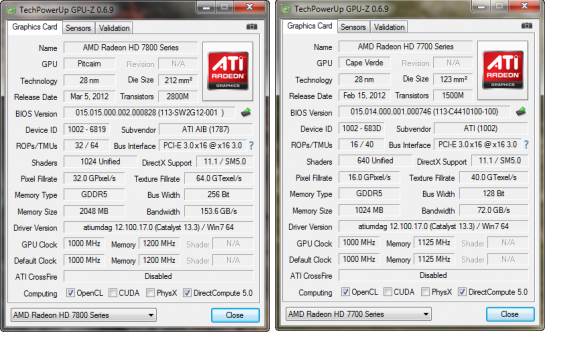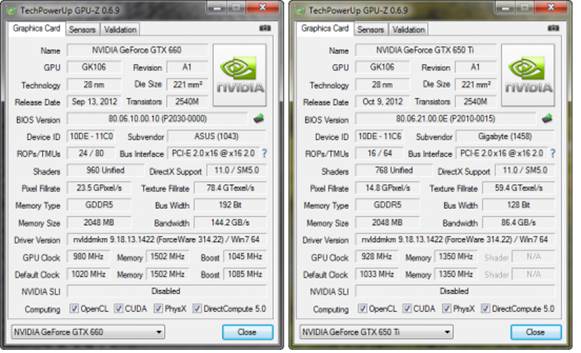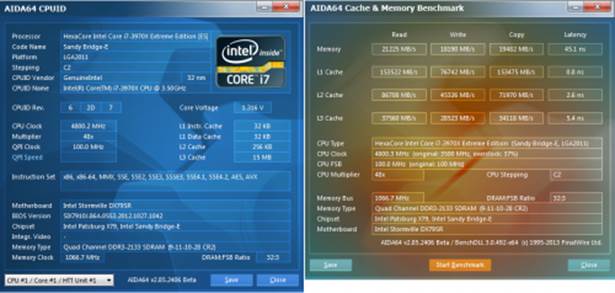Besides competing with each other, the
Radeon HD 7790 and GeForce GTX 650 Ti Boost will be compared with similar
priced products. Radeon HD 7850 is represented by a product from the HIS
whereas the Radeon HD 7770 GHz Edition is a reference card from AMD.

Radeon
HIS HD 7850

TechPowerUp
GPU-Z 0.6.9
The screenshot of Radeon HIS HD 7850 shows
an increased GPU frequency, but we dropped it to the standard level (840 MHz)
for our testing.
The GeForce GTX 650 Ti Boost is bracketed
in Nvidia’s hierarchy by the GeForce GTX 660, represented in this review by an
ASUS's product and by the ordinary GeForce GTX 650 Ti which is represented by a
Gigabyte card.

Comparable
represented products

TechPowerUp
GPU-Z 0.6.9
As you can see, we have tested them at
standard clock rates.
In order to lower the dependence of the
graphics cards performance on the overall platform speed, I overclocked our 32
nm
six-core CPU with the multiplier set at 48x, BCLK
frequency set at 100 MHz and “Load-Line Calibration” enabled to 4.8 GHz. The
processor Vcore was increased to 1,385 V in the mainboard BIOS:

AEDA64-CPUID
Hyper-Threading technology was enabled. 16
GB of system DDR3 memory worked at 2.133 GHz frequency with 9-11-10-28 timings
and 1.65V voltage.
The test session started on March 31, 2013.
All tests were performed in Microsoft Windows 7 Ultimate x64 SP1 with all
critical updates as of that date and the following drivers:
·
Intel Chipset Drivers 9.4.0.1017 WHQL from
02/07/2013 for the mainboard chipset;
·
DirectX End-User Runtimes libraries from
November 30, 2010
·
AMD Catalyst 13.3 Beta 3 driver from 03/20/2013
+ Catalyst Application Profiles 12.11 (CAP2) for AMD based graphics cards
·
Nvidia GeForce 314.22 WHQL driver from
03/25/2013 for Nvidia based graphics cards
Since we are
discussing lower performance graphics cards, we only tested them in a single
resolution – 1,920x1,080. Lower resolutions start making less sense to look at
because Full HD monitors are getting more and more affordable. The tests were
conducted with two image quality modes: “Quality+AF16x” – default texturing
quality in the drivers with enabled 16x anisotropic filtering and “Quality+
AF16x+MSAA 4x” with enabled 16x anisotropic filtering and full screen 4x
antialiasing. We also enabled anisotropic filtering and full-screen
anti-aliasing from the game settings. If the corresponding options were
missing, we changed these settings in the Control Panels of Catalyst and
GeForce drivers. Here, we also disabled Vsync. Without any other changes in the
driver settings.
As usual, we have expanded and updated our
benchmarking system. We remove the Unigine Heaven benchmark, which is
practically duplicating the newer Valley test. Moreover besides the previously
added Resident Evil 6, Crysis 3 and Tomb Raider (2013), we also included in the
new game known as StarCraft 2: Heart of the Swarm and BioShock Infinite. Of
course, we haven’t forgotten about all the latest updates, which are current at
the time of tests. Up to now, our benchmarking suite includes two popular
semi-synthetic benchmarks, one demo and 15 resource-consuming games of various
genres:
·
3DMark 2011 (DirectX 11) – version 1.0.3.0,
Performance and Extreme profiles;
·
3DMark 2013 (DirectX 9/11) – version 1.0,
benchmarks in “Cloud Gate”, “Fire Strike” and “Fire Strike Extreme” scenes
·
Unigine Valley Bench (DirectX 11) – version 1.0,
maximum image quality settings, AF16x and(or) MSAA 4x, 1,980x1,080 resolution
·
Resident Evil 6 Bench (DirectX 9) – version 1.0,
all settings adjusted for maximum quality, FXAA3HQ antialiasing, Blur enabled,
1,920x1,080 and 2,560x1,440 resolutions;
·
S.T.A.L.K.E.R.: Call of Pripyat (DirectX 11) –
version 1.6.02, Enhanced Dynamic DX11 Lighting profile with all parameters
manually set at their maximums, we used our custom cop03 demo on the Backwater
map
·
Metro 2033: The Last Refuge (DirectX 10/11) -
version 1.2, maximum graphics quality settings, official benchmark, “High”
image quality settings; tesselation, DOF and MSAA4x disabled; AAA aliasing
enabled, two consecutive runs of the “Frontline” scene
·
Aliens vs. Predator (2010) (DirectX 11) –
Texture Quality “Very High”, Shadow Quality “High”, SSAO On, two test runs in
each resolution
·
Total War: Shogun 2: Fall of the Samurai
(DirectX 11) – version 1.1.0, built-in benchmark (Sekigahara battle) at maximum
graphics quality settings and enabled MSAA 8x in one of the test modes
·
Crysis 2 (DirectX 11) – version 1.9, we used
Adrenaline Crysis 2 Benchmark Tool v.1.0.1.14. BETA with “Ultra High” graphics
quality profile and activated HD textures, two runs of a demo recorded on
“Times Square” level
·
Battlefield 3 (DirectX 11) – version 1.4, all
image quality settings set to “Ultra”, two successive runs of a scripted scene
from the beginning of the “Going Hunting” mission 110 seconds long
·
Sniper Elite V2 Benchmark (DirectX 11) – version
1.05, we used Adrenaline Sniper Elite V2 Benchmark Tool v1.0.0.2 BETA with maximum
graphics quality settings (“Ultra” profile), Advanced Shadows: HIGH, Ambient
Occlusion: ON, Stereo 3D: OFF, two sequential test runs
·
Sleeping Dogs (DirectX 11) – version 1.5, we
used Adrenaline Sleeping Dogs Benchmark Tool v1.0.0.3 BETA with maximum image
quality settings, Hi-Res Textures pack installed, FPS Limiter and V-Sync
disabled, two consecutive runs of the built-in benchmark with quality
antialiasing at Normal and Extreme levels
·
F1 2012 (DirectX 11) – update 10, we used
Adrenaline Racing Benchmark Tool v1.0.0.13 with “Ultra” image quality settings
during two laps on Brazilian “Interlagos” race track with 24 other cars and a
drizzling rain; we also used “Bonnet” camera mode
·
Borderlands 2 (DirectX 9) – version 1.3.1,
built-in benchmark with maximum image quality settings and maximum PhysX level,
FXAA enabled
·
Hitman: Absolution (DirectX 11) – version
1.0.446.0, built-in test with Ultra image quality settings, with enabled
tessellation, FXAA and global lighting
·
Crysis 3 (DirectX 11) – version 1.0.1.3, all
graphics quality settings at maximum, Motion Blur amount – Medium, lens flares
– on, FXAA and MSAA4x modes enabled, two consecutive runs of a scripted scene
from the beginning of the “Swamp” mission 110 seconds long
·
Tomb Raider (2013) (DirectX 11) – version
1.1.732.1, all image quality settings set to “Ultra”, V-Sync disabled, FXAA and
2x SSAA antialiasing enabled, TessFX technology activated, two consecutive runs
of the benchmark built into the game
·
StarCraft II” Heart of the Swam (DirectX 10) – version
2.0.6.25180, texture quality settings at “Ultra”, all other image quality
settings at maximum, two consecutive runs of the pre-recorded demo with a mass
battle 110 seconds long
·
BioShock Infinite (DirectX 11) – version
1.1.21.26939, we used Adrenaline Action Benchmark Tool v1.0.2.1, two
consecutive runs of the built-in benchmark with “Ultra” and “Ultra+DOF” quality
settings
If the games
allow recording the minimum fps, they will be added to the diagram. We ran each
game test or benchmark twice and took the best result for the diagrams, but
only if the difference between them didn’t exceed 1% If it did exceeds 1%, we
ran the tests at least one more time to achieve repeatability of results.